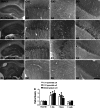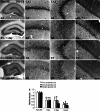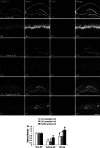The reverse roles of transient receptor potential canonical channel-3 and -6 in neuronal death following pilocarpine-induced status epilepticus
- PMID: 22926417
- PMCID: PMC11498003
- DOI: 10.1007/s10571-012-9875-6
The reverse roles of transient receptor potential canonical channel-3 and -6 in neuronal death following pilocarpine-induced status epilepticus
Abstract
Transient receptor potential canonical channel (TRPC) is a nonselective cation channel permeable to Ca(2+), which is expressed in many cell types, including neurons. However, the alterations in TRPC receptor expressions in response to status epilepticus (SE) have not been explored. Therefore, the present study was designated to elucidate the roles of TRPC3 and TRPC6 in neuronal death following SE. In non-SE animals, TRPC3 and TRPC6 immunoreactivity was abundantly detected in the dendrites of pyramidal cells and the cell bodies of dentate granule cells. Following SE, TRPC3 expression was significantly elevated in CA1-, CA3 pyramidal cells, and dentate granule cells, while TRPC6 expression was reduced in these regions. Pyrazole-3 (a TRPC3 inhibitor) effectively prevented up-regulation of neuronal TRPC3 expression induced by SE. Hyperforin (a TRPC6 activator) effectively prevented down-regulation of neuronal TRPC6 expression induced by SE. In addition, both Pyr3 and hyperforin effectively protected neuronal damages from SE. Therefore, the present study yields novel information regarding the role of TRPC3 and 6 in epileptogenic insults and suggests that TRPC 3 and 6 may be involved in neurodegeneration following SE.
Figures





Similar articles
-
Endothelial transient receptor potential conical channel (TRPC)-3 activation induces vasogenic edema formation in the rat piriform cortex following status epilepticus.Cell Mol Neurobiol. 2013 May;33(4):575-85. doi: 10.1007/s10571-013-9931-x. Epub 2013 Mar 26. Cell Mol Neurobiol. 2013. PMID: 23529532 Free PMC article.
-
Upregulation and Diverse Roles of TRPC3 and TRPC6 in Synaptic Reorganization of the Mossy Fiber Pathway in Temporal Lobe Epilepsy.Mol Neurobiol. 2015 Aug;52(1):562-72. doi: 10.1007/s12035-014-8871-x. Epub 2014 Sep 12. Mol Neurobiol. 2015. PMID: 25213992
-
TRPC6-Mediated ERK1/2 Activation Increases Dentate Granule Cell Resistance to Status Epilepticus Via Regulating Lon Protease-1 Expression and Mitochondrial Dynamics.Cells. 2019 Nov 1;8(11):1376. doi: 10.3390/cells8111376. Cells. 2019. PMID: 31683954 Free PMC article.
-
Investigating Contributions of Canonical Transient Receptor Potential Channel 3 to Hippocampal Hyperexcitability and Seizure-Induced Neuronal Cell Death.Int J Mol Sci. 2024 Jun 6;25(11):6260. doi: 10.3390/ijms25116260. Int J Mol Sci. 2024. PMID: 38892448 Free PMC article.
-
TRPC Channels and Epilepsy.Adv Exp Med Biol. 2017;976:123-135. doi: 10.1007/978-94-024-1088-4_11. Adv Exp Med Biol. 2017. PMID: 28508318 Review.
Cited by
-
Roles of TRP Channels in Neurological Diseases.Oxid Med Cell Longev. 2020 Sep 4;2020:7289194. doi: 10.1155/2020/7289194. eCollection 2020. Oxid Med Cell Longev. 2020. PMID: 32963700 Free PMC article. Review.
-
Homeostasis or channelopathy? Acquired cell type-specific ion channel changes in temporal lobe epilepsy and their antiepileptic potential.Front Physiol. 2015 Jun 15;6:168. doi: 10.3389/fphys.2015.00168. eCollection 2015. Front Physiol. 2015. PMID: 26124723 Free PMC article. Review.
-
TRPC channels as emerging targets for seizure disorders.Trends Pharmacol Sci. 2022 Sep;43(9):787-798. doi: 10.1016/j.tips.2022.06.007. Epub 2022 Jul 12. Trends Pharmacol Sci. 2022. PMID: 35840362 Free PMC article. Review.
-
The role of canonical transient receptor potential channels in seizure and excitotoxicity.Cells. 2014 Apr 9;3(2):288-303. doi: 10.3390/cells3020288. Cells. 2014. PMID: 24722470 Free PMC article.
-
TRPC Channels: Prominent Candidates of Underlying Mechanism in Neuropsychiatric Diseases.Mol Neurobiol. 2016 Jan;53(1):631-647. doi: 10.1007/s12035-014-9004-2. Epub 2014 Dec 15. Mol Neurobiol. 2016. PMID: 25502458 Review.
References
-
- Bedi KS (1991) Early-life undernutrition causes deficits in rat dentate gyrus granule cell number. Experientia 47:1073–1074 - PubMed
-
- Carrillo C, Hichami A, Andreoletti P, Cherkaoui-Malki M, Del Mar Carvia M, Abdoul-Azize S, Alonso-Torre SR, Khan NA (2012) Diacylglycerol-containing oleic acid induces increases in [Ca(2+)](i) via TRPC3/6 channels in human T cells. Biochim Biophys Acta 1821:618–626 - PubMed
-
- Cheung KK, Yeung SS, Au SW, Lam LS, Dai ZQ, Li YH, Yeung EW (2011) Expression and association of TRPC1 with TRPC3 during skeletal myogenesis. Muscle Nerve 44:358–365 - PubMed
Publication types
MeSH terms
Substances
LinkOut - more resources
Full Text Sources
Miscellaneous

